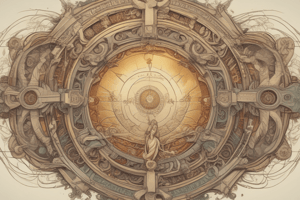Podcast
Questions and Answers
What is a defining characteristic of deconstructionist architects?
What is a defining characteristic of deconstructionist architects?
- Revolutionary ideas and testing new boundaries (correct)
- Emphasizing harmony and balance in design
- Strict adherence to humanist architectural values
- Following traditional architectural principles
What was the approach of deconstructionist architects towards design ideas and form?
What was the approach of deconstructionist architects towards design ideas and form?
- Form and function prioritized over design ideas
- Design idea secondary to form and function
- Form and function considered irrelevant in design
- Design idea more important than form and function (correct)
How did deconstructionist architects view the use of volumes and forms in their projects?
How did deconstructionist architects view the use of volumes and forms in their projects?
- They focused on creating perfectly symmetrical forms
- They used incomplete forms in their projects (correct)
- They avoided using volumes in their designs
- They strictly adhered to traditional forms in architecture
What is a defining characteristic of deconstructionist architects?
What is a defining characteristic of deconstructionist architects?
How did deconstructionist architects view the relationship between order and chaos?
How did deconstructionist architects view the relationship between order and chaos?
What was the approach of deconstructionist architects towards form and function in architecture?
What was the approach of deconstructionist architects towards form and function in architecture?
Explain the concept of anti-humanism in deconstruction architecture and how it was manifested in the projects of deconstructionist architects.
Explain the concept of anti-humanism in deconstruction architecture and how it was manifested in the projects of deconstructionist architects.
How did deconstructionist architects incorporate the idea of oppositions in their conceptual ideas for projects?
How did deconstructionist architects incorporate the idea of oppositions in their conceptual ideas for projects?
Discuss the significance of the relationship between order and chaos in deconstruction architecture and its impact on architectural theory and practice.
Discuss the significance of the relationship between order and chaos in deconstruction architecture and its impact on architectural theory and practice.
Flashcards are hidden until you start studying
Study Notes
Deconstructionist Architects
- A defining characteristic of deconstructionist architects is their rejection of traditional notions of form and function in architecture.
- They approached design ideas and form by questioning and challenging traditional notions of beauty, harmony, and balance.
- Deconstructionist architects viewed the use of volumes and forms in their projects as a means to create a sense of dislocation, fragmentation, and disorder.
- They saw the relationship between order and chaos as a central theme in their work, often creating a sense of tension and conflict between the two.
Form and Function
- Deconstructionist architects rejected the traditional notion of form following function, instead, they often privileged form over function.
- They saw function as a secondary consideration, and form as the primary driver of their design.
Anti-Humanism
- Anti-humanism in deconstruction architecture refers to the rejection of traditional notions of human-centered design.
- It involves the creation of buildings that are not necessarily designed to meet the needs of human users, but rather to challenge and subvert traditional notions of architecture.
- Deconstructionist architects incorporated anti-humanism into their projects by designing buildings that were often uncomfortable, disorienting, and challenging to navigate.
Oppositions
- Deconstructionist architects often incorporated the idea of oppositions into their conceptual ideas for projects, such as oppositions between order and chaos, or between different shapes and forms.
- They saw oppositions as a way to create a sense of tension and conflict in their designs, and to challenge traditional notions of harmony and balance.
Impact on Architectural Theory and Practice
- The relationship between order and chaos in deconstruction architecture has had a significant impact on architectural theory and practice.
- It has challenged traditional notions of beauty, harmony, and balance, and has opened up new possibilities for architectural design.
- Deconstructionist architecture has also influenced the development of new design styles and approaches, and has continues to shape architectural theory and practice today.
Studying That Suits You
Use AI to generate personalized quizzes and flashcards to suit your learning preferences.




